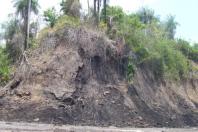How threatened is Uinta Basin’s rare desert flower?
By Brian Maffly
| The Salt Lake Tribune
Dec 01 2013
Graham’s and White River beardtongue are rare desert flowers that grow almost exclusively in Uintah County’s badlands. But these plants, also known as penstemon, sink their roots into Green River Formation shales, putting their conservation on a collision course with a vast yet untapped hydrocarbon resource.
For reasons that are not well understood, these beardtongue species appear only near Utah’s oil shale outcrops, known as the Mahogany Ledge, federal officials say.
These are the very places that energy developers intend to mine in coming years, in the hope of achieving a long-standing dream of recovering actual oil from rock rich in kerogen, the promising organic source.
Just as plans are hatching to develop two big oil shale mines, the U.S. Fish and Wildlife Service has proposed listing the rare plants as threatened species. A final ruling is due in July.
An industry lobbyist last week told Utah lawmakers that listing beardtongue would kill U.S. oil shale production. The plant isn’t even that rare, Jeff Hartley testified before an interim natural resources committee.
"In fact, that flower grows all over Uintah, Carbon and Duchesne counties. There are four species of cousin penstemon that have identical DNA," said Hartley, vice president for governmental affairs for Red Leaf Resources, which is about to win state approval to begin mining and processing oil shale in southern Uintah County.
But botantists roundly reject Hartley’s claim.
—
A barren affinity » A member of the figwort family, penstemon is among the most diverse plant genera in Utah, with as many as 30 species growing in the Uinta Basin. And Graham’s, with its big pink flowers, is perhaps the most distinct species, according to Jessica Brunson, a botanist with the Bureau of Land Management’s Vernal office.
"It’s a classic case of a species that has adapted for a particular niche. They really like these barren areas," Brunson said. "I don’t think it’s the oil shale itself. We have a lot of endemics that like to grow in harsh places."
Graham’s occupies a horseshoe-shaped band 6 miles wide stretching 80 miles across southern Uintah County.
The proposed listings seek to designate 68,000 acres of critical habitat, two-thirds of which is federal land, for Graham’s beardtongue. About 40 percent of the 15,000 acres to be designated for the rarer White River beardtongue is federally owned.
In the midst of this habitat, an American subsidiary of the Estonian company Enefit is poised to mine a dark striated seam of Green River Formation that will yield 27 gallons of crude for every ton of ore.
According to the Fish and Wildlife Service, Enefit American Oil’s 26,000-acre project area harbors 26 percent of all known White River beardtongue plants and 19 percent of Graham’s beardtongue.
"We estimate that as much as 82 [to] 94 percent of the total known populations of Graham’s and White River beardtongues will be vulnerable to both direct loss and indirect negative impacts such as habitat fragmentation from oil shale and tar sands development," states the proposed listing, which Brunson helped craft when she worked for Fish and Wildlife last year.
"These levels of impact are likely to lead to severe declines in both species across their ranges," it reads.
—
Overstated threat? » Utah Gov. Gary Herbert’s office has blasted these findings, arguing they are "arbitrary and capricious" because they are based on weak assumptions rather than the best available science.
The feds’ proposal overstates the threats oil shale development poses to the plants and fails to consider recent surveys that indicate beardtongue populations are far larger than the agency claims, according to comments submitted by Kathleen Clarke, the governor’s public lands policy coordinator.
"The presence of large and significant gaps in our understanding of the distribution and abundance of both species strongly suggests that the Service is not employing the best available data to characterize the nature of the existing populations," Clarke wrote.
"As a result," she wrote, "the Service cannot accurately assess threats to the species and thereafter accurately determine the need for listing."
Hartley’s recent testimony went further, impugning the feds’ motives.
"The reality is [Fish and Wildlife officials] are trying list these species to shut down energy production. They don’t even try to hide it. It’s blatant," Hartley said while asking lawmakers to fund efforts to challenge federal endangered-species decisions.
"It is not our goal to foreclose any kind development. We typically look at ways to conserve a species and allow development to move forward," Crist said. "We try to come up with ways to have a win-win for the species and the people who use the land."
He pointed to the agency’s decision to not list the Coral Pink Sand Dunes tiger beetle, which lives only on its namesake dunes in southern Utah, after Kane County and state officials helped craft a conservation plan that balanced beetle habitat and continued motorized use of the dunes.
—
A local alternative » Uintah County officials are now pursuing the same strategy for beardtongue with the help of $20,000 from state agencies. In concert with BLM and the Utah School and Institutional Trust Lands Administration, the county is developing a beardtongue plan that aims to forestall a federal listing.
Critical to such a plan is developers’ commitment to mining practices that minimize disturbance and repair damage, even on private land.
Surface mining over much of Enefit’s project area isn’t possible because the oil shale is too deep. Where the surface is mined, Enefit and Red Leaf promise to reclaim the land as they go, returning the overlying rock to the pit, contouring it and seeding the ground with native flora.
But officials say time is short for demonstrating such measures work.
"Reclaiming dry environments can be very difficult. We would like success criteria for that before we move on," Crist said. "There is a tight timeline to do this. We don’t have a whole lot of time to come up with a conservation agreement."
http://www.sltrib.com/sltrib/news/57181303-78/species-beardtongue-oil-shale.html.csp


